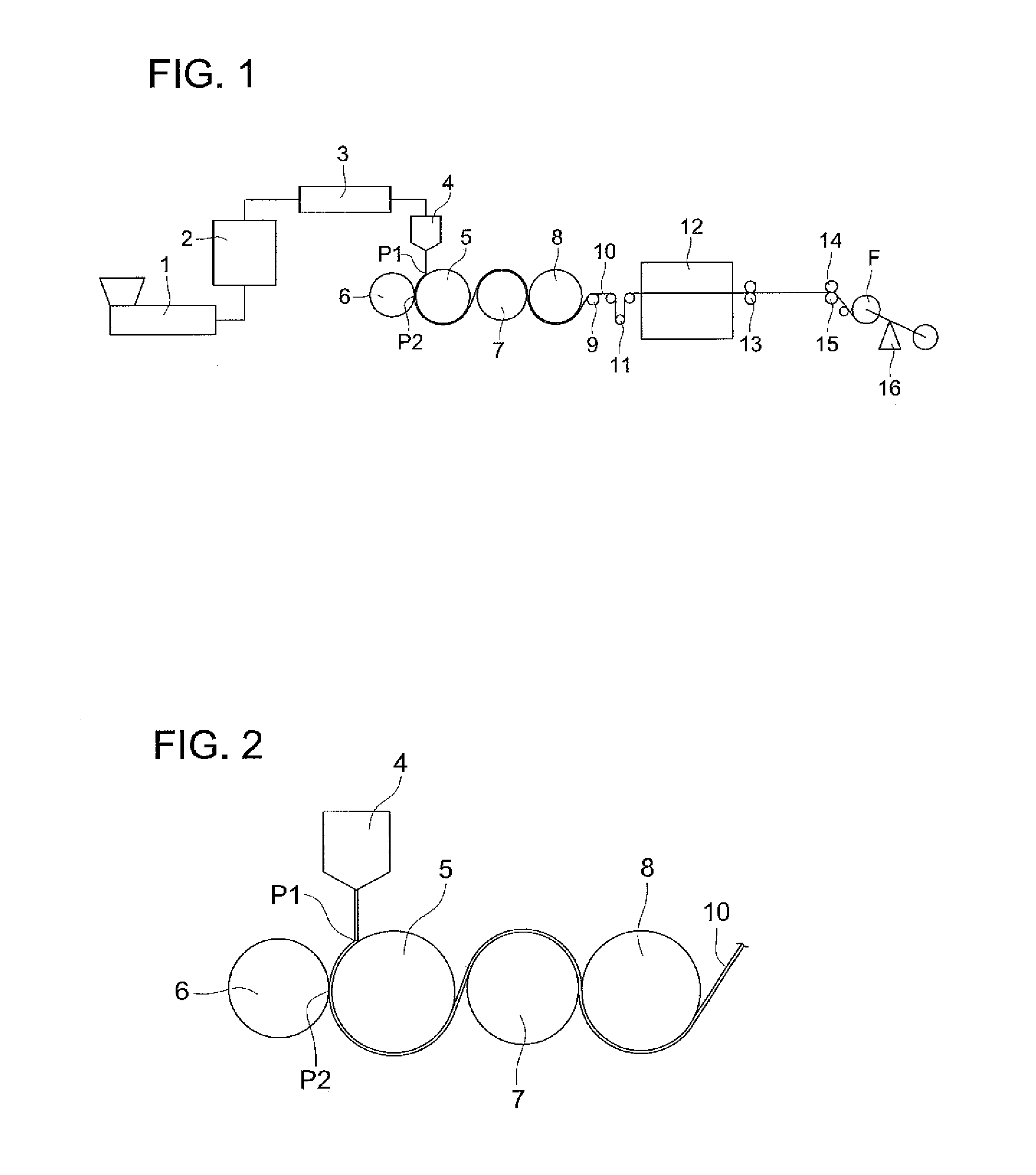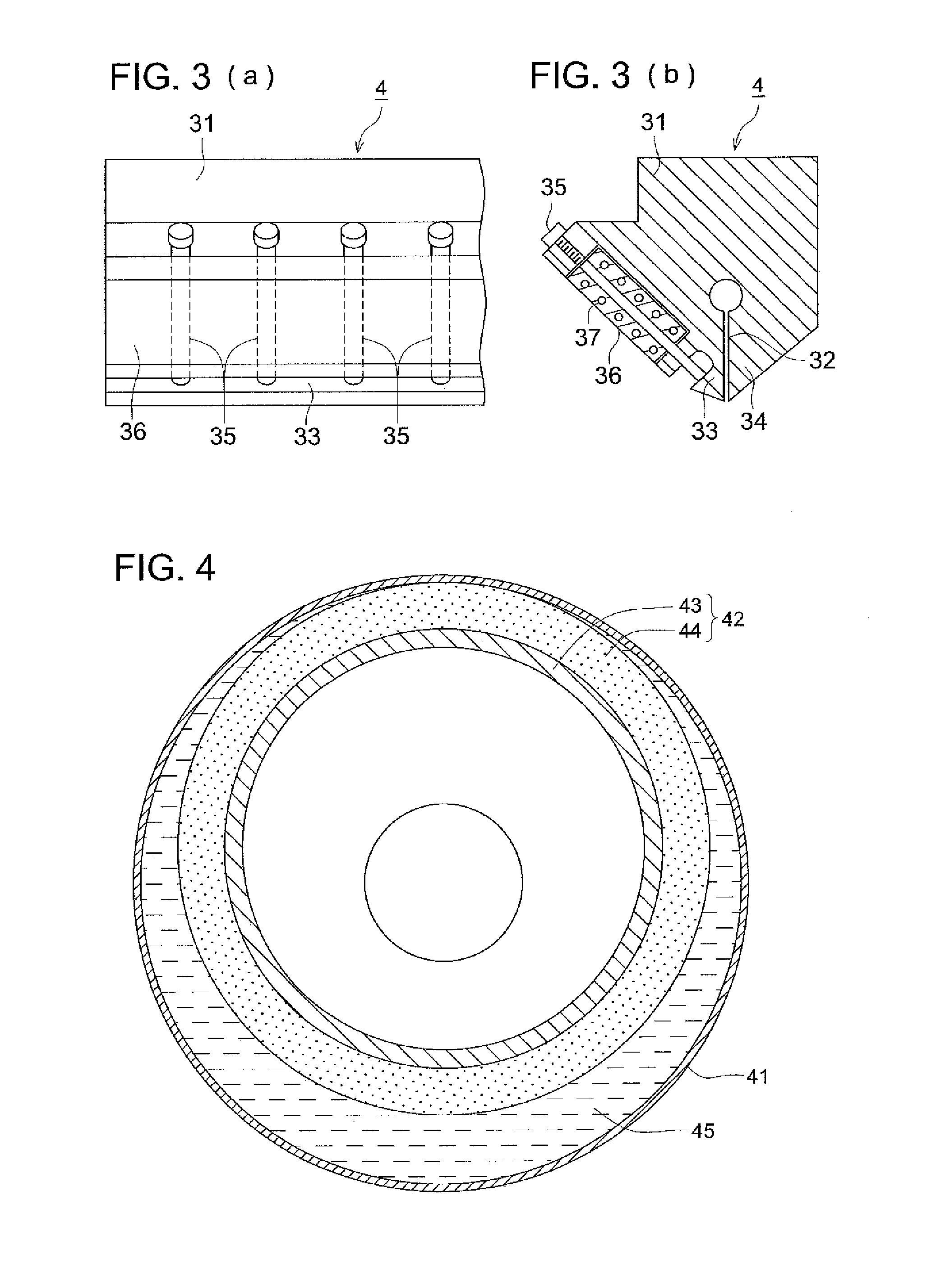Method of producing cellulose ester film, cellulose ester film, polarizing plate and liquid crystal display
a technology cellulose ester film, which is applied in the field of producing cellulose ester film, cellulose ester film, polarizing plate and liquid crystal display, can solve the problems of difficult to increase the production of cellulose ester film using the solution-casting method, high environmental load, and large volume of organic solvents followed by high environmental load, so as to reduce moisture permeability, improve the effect of flatness and reduce bleeding
- Summary
- Abstract
- Description
- Claims
- Application Information
AI Technical Summary
Benefits of technology
Problems solved by technology
Method used
Image
Examples
synthesis example 1
Synthesis of Cellulose Ester Resin 1
[0413]Synthesis was performed referring to example B of Japanese Translation of PCT International Application Publication No. 6-501040.
[0414]Following mixed solutions A-E were prepared.[0415]A: Propionic acid:concentrated sulfuric acid=5:3 (mass ratio)[0416]B: Acetic acid:pure water=3:1 (mass ratio)[0417]C: Acetic acid:pure water=1:1 (mass ratio)[0418]D: Acetic acid:pure water:magnesium carbonate=12:11:1 (mass ratio)[0419]E: An aqueous solution in which 0.5 mol of potassium carbonate and 1.0 mol of citric acid were dissolved in 14.6 kg of pure water
[0420]In a reaction vessel equipped with a mechanical stirrer, charged were 100 mass parts of cellulose purified from cotton, 317 mass parts of acetic acid and 67 mass parts of propionic acid, the resulting solution was stirred for 30 minutes at 55° C. After the temperature of the reaction vessel was cooled to 30° C., the solution was added with 2.3 mass parts of solution A and stirred for 30 minutes. A...
synthesis example 2
Synthesis of Pentaerythritol Teterapivaiate (PETP)
[0430]Pentaerythritol teterapivaiate, which is utilized in an example of patent literature 5 as PL2, was synthesized.
[0431]In a solution containing 34 mass parts of pentaerythritol, 101 mass parts of triethylamine and 2,000 mass parts of ethyl acetate, 121 mass parts of pivaloyl chloride was added in drops over 30 minutes at an ambient temperature, and stirring was further continued for 1 hour. Then produced white precipitate was removed by filtration and the product was washed by addition of pure water. The organic phase was separated and the organic solvent was removed by evaporation under reduced pressure, whereby 89 mass parts (yield of 75%) of white crystals were obtained. Herein, the molecular weight of this compound was 473.
synthesis example 3
Synthesis of Compound (B-7) Used in the Examples
[0432]Mixed were 76 mass parts trimethylene glycol, 535 mass parts of phenyl salicylate and 1 mass part of potassium carbonate. The mixture was heated at 155° C. for 3 hours under a pressure of 1.33×104 Pa. While the heating, 188 mass parts of phenol was distilled away. After the pressure was brought to ambient pressure, the vessel was cooled to 100° C. and 0.5 mass part of concentrated sulfuric acid and 225 mass parts of acetic anhydride were added followed by agitating at 100° C. for 1 hour. After the reaction was over, 1000 mass parts of toluene was added and the vessel was cooled with ice, whereby white crystals were obtained. The white crystals were separated by filtration and washed twice with pure water followed by drying under reduced pressure at 30° C. to obtain 224 mass parts of white crystals (yield of 56%). The molecular weight of this compound was 400.
PUM
| Property | Measurement | Unit |
|---|---|---|
| carbon number | aaaaa | aaaaa |
| carbon number | aaaaa | aaaaa |
| mol % | aaaaa | aaaaa |
Abstract
Description
Claims
Application Information
 Login to View More
Login to View More - R&D
- Intellectual Property
- Life Sciences
- Materials
- Tech Scout
- Unparalleled Data Quality
- Higher Quality Content
- 60% Fewer Hallucinations
Browse by: Latest US Patents, China's latest patents, Technical Efficacy Thesaurus, Application Domain, Technology Topic, Popular Technical Reports.
© 2025 PatSnap. All rights reserved.Legal|Privacy policy|Modern Slavery Act Transparency Statement|Sitemap|About US| Contact US: help@patsnap.com



